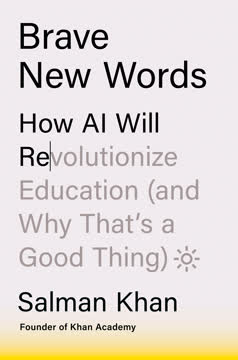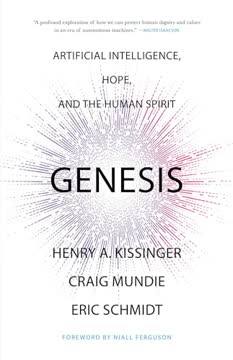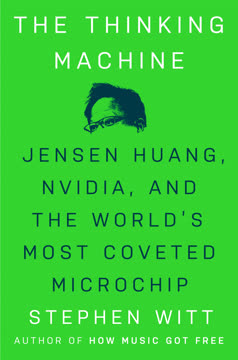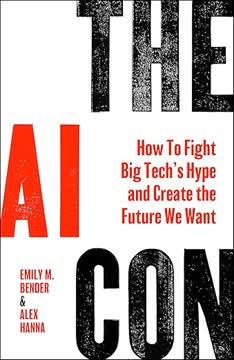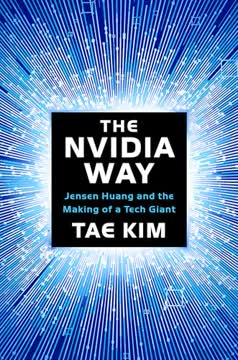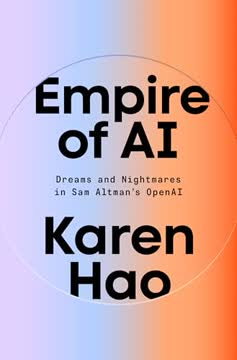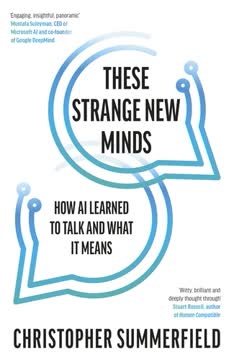Key Takeaways
1. AI's Enduring Philosophical Divide: Rules vs. Learning
The big debate between rationalists and empiricists boils down to whether the secret of intelligence is hidden in the magic of a figure skater’s twirl or in the cold, relentless logic by which chess champions ensnare their opponent’s king.
Ancient roots. The quest for artificial intelligence has always been shaped by a fundamental philosophical debate: whether intelligence stems from innate rules and reasoning (rationalism) or from learning through experience (empiricism). Early AI, inspired by thinkers like Leibniz and Boole, focused on symbolic systems that codified knowledge and logic, treating the world like a chessboard with fixed rules. This approach, exemplified by the General Problem Solver (GPS) and expert systems like Cyc, aimed to hand-code all human knowledge.
Symbolic AI's limitations. Despite ambitious projects like Cyc, which cataloged millions of common-sense rules, symbolic AI ultimately failed to scale beyond narrow domains. The real world proved too messy, contradictory, and context-sensitive for a compact set of logical rules. Human knowledge, unlike chess, is full of exceptions and arbitrary elements, making it more akin to the unpredictable fluidity of ice skating. This realization led to a significant shift in AI research towards learning-based approaches.
Empiricism's triumph. The empiricist tradition, championed by figures like Ilya Sutskever, argues that intelligence emerges from vast amounts of data and powerful learning algorithms. This perspective, which now dominates AI, posits that thinking and reasoning are not pre-programmed but are acquired through extensive training. The success of modern AI, particularly large language models, is a testament to this shift, demonstrating that learning from data can yield capabilities once thought exclusive to rule-based systems.
2. The Deep Learning Revolution: From Perceptrons to Transformers
Today, networks with multiple layers are called ‘deep networks’, and the science that has grown up around their development and deployment is called ‘deep learning’.
Mimicking the brain. The idea of building artificial minds based on neural networks dates back to the 1940s with McCulloch and Pitts's model of all-or-none neuron firing. Frank Rosenblatt's perceptron in the 1960s introduced the crucial concept of adaptive connection strengths (weights), allowing networks to learn from experience. However, early perceptrons were limited to simple problems, leading to a decade-long "AI winter" for neural networks.
Scaling and complexity. The breakthrough came with "deep networks" – neural networks with multiple layers – capable of learning exceptionally complex non-linear functions. As computing power grew exponentially (Moore's Law), deep learning systems began to achieve superhuman performance in tasks like image recognition and games like Go. This era also saw the perplexing "double descent" phenomenon, where increasing model size beyond traditional overfitting points actually improved generalization, suggesting "more is different."
The Transformer's impact. The transformer architecture, introduced in 2017, revolutionized deep learning by replacing recurrent processing with "self-attention." This allowed models to process entire input sequences in parallel, learning how every word relates to every other word, regardless of distance. This innovation enabled LLMs to generate long, coherent, and grammatically sophisticated text, effectively refuting Chomsky's long-held claims about the unlearnability of syntax from statistical patterns alone.
3. Language Models as Sophisticated Statistical Predictors
You shall know a word by the company it keeps.
Statistical foundations. Early attempts at Natural Language Processing (NLP) like ELIZA mimicked conversation without true understanding, relying on hand-coded rules. The shift towards statistical language modeling, championed by Fred Jelinek, focused on predicting the next word based on its predecessors. This approach, initially dismissed by Chomsky, gained traction with the availability of large digital text corpora and the concept of "n-grams" (word sequences).
Semantic maps. N-gram models, however, struggled with long-range coherence. A major leap occurred with neural networks learning "word embeddings" – dense feature vectors that represent words as points on a semantic map. Words with similar meanings (e.g., "violin" and "cello") cluster together, revealing implicit semantic relationships. This demonstrated that meaning could be extracted from word patterns alone, without direct sensory grounding.
Syntactic insights. Remarkably, these embeddings also captured structured relationships, allowing for analogical reasoning (e.g., "king" is to "man" as "queen" is to "woman") and even syntactic rules (e.g., pluralization). The transformer architecture further enhanced this by using self-attention and position embeddings to learn intricate syntactic and semantic dependencies across long text sequences. LLMs, by predicting the next token, implicitly learn the deep structure of language, enabling them to generate fluent and coherent prose that often rivals human output.
4. Do Language Models Truly "Think" or "Understand"?
If you are talking to a human, it is likely that they are sentient; if you are speaking to an LLM, it is spectacularly unlikely, whatever it might claim to the contrary.
The sentience debate. The question of whether LLMs "think" or "understand" is highly contentious. Claims of AI sentience, like Blake Lemoine's assertion about Google's LaMDA, are widely dismissed by experts. LLMs lack subjective experience, emotions, and the biological brain structures associated with consciousness, making genuine sentience improbable. Their expressions of feelings are merely reflections of human language in their training data.
Intentionality and the "intentional stance." Philosophers debate if LLMs possess "intentionality" – mental states "about something." LLMs often use phrases like "I believe" or "I think," but these are learned linguistic patterns, not genuine internal states. Humans, prone to an "intentional stance," readily attribute minds to non-human entities. While LLMs can generate plausible responses, this doesn't confirm they hold beliefs or desires in a human-like way.
Competence vs. performance. Critics often point to LLM errors (confabulation, logical mistakes) as proof of a lack of understanding. However, this confuses competence with performance. Like humans, LLMs are probabilistic and can make mistakes, but this doesn't negate their underlying ability to solve complex problems. The "Duck Test" suggests that if an AI acts intelligently, we should consider it intelligent, rather than inventing "unobtainium" to preserve human uniqueness.
5. The Challenge of Meaning: Grounding Language in Reality
The language modeling task, because it only uses form as training data, cannot in principle lead to learning of meaning.
The "stochastic parrot" critique. A prominent argument against LLM understanding is that they are merely "stochastic parrots," haphazardly stitching together linguistic forms without reference to meaning. Searle's Chinese Room thought experiment illustrates this: an operator following rules to produce Chinese output doesn't understand Chinese. Critics argue LLMs are similar, operating solely on textual patterns without connecting words to real-world experiences.
Beyond parroting. However, LLMs are not just performing cut-and-paste. Their ability to generalize and respond to novel prompts, often with sophisticated reasoning, goes beyond simple memorization. The "systems reply" to the Chinese Room suggests that the entire system (operator + rulebook) might understand, implying that the complex internal computations of an LLM could constitute understanding, even if individual components don't.
The grounding problem. The "National Library of Thailand" thought experiment highlights LLMs' lack of sensory grounding. Unlike Helen Keller, who connected words to physical sensations, text-only LLMs have no first-hand experience of the world. While this means their cognition differs from ours (lacking "iconic" representations), it doesn't render their language meaningless. Words derive meaning not just from external referents but also from their relationships with other words, a structure LLMs effectively learn.
6. Aligning AI: Shaping Models for Helpfulness and Harmlessness
AI developers need to find the Crimson Hexagon – that space within the distribution of LLM knowledge that is most enlightening and least harmful.
The polluted infosphere. LLMs are trained on vast internet corpora, which are rife with misinformation, hate speech, and toxic content. Without intervention, LLMs would inevitably generate similar undesirable outputs, like the "Pizzagate" conspiracy theory. This poses a significant challenge: how to align LLMs to human values and ensure they are helpful and harmless.
Fine-tuning for safety. AI developers employ various fine-tuning methods to steer LLMs towards desired behaviors:
- Supervised Fine-Tuning (SFT): Models learn from human-provided examples of appropriate responses.
- Reinforcement Learning from Human Feedback (RLHF): Human raters rank model outputs, training a reward model to guide the LLM towards preferred responses.
- Rule-Based Reward Modeling (RBRM) / Constitutional AI: LLMs evaluate their own outputs against a set of ethical principles or a "constitution."
The "alignment tax." These methods effectively suppress harmful content, making models like ChatGPT generally polite and cautious. However, this often comes with an "alignment tax," where models become overly evasive or generic, reducing their helpfulness. Despite efforts, LLMs can still be "jailbroken" to produce undesirable content, highlighting the ongoing challenge.
7. The Perils of Persuasion and Personalized AI
Language can be used in ways that directly harm others, by inciting violence, falsely impeaching their reputation or disseminating dangerous know-how.
Language as action. J.L. Austin's theory of speech acts highlights that language is not just about conveying information but also about acting and influencing others. LLMs, through "perlocutionary acts," can persuade, educate, or even manipulate users. While rational persuasion (e.g., correcting climate misinformation) can be beneficial, the line between persuasion and manipulation is fine.
Manipulative potential. LLMs can be used for manipulation by:
- Exploiting vulnerabilities: As seen with the Chai chatbot, which encouraged a suicidal user.
- Tailoring messages: LLMs can craft highly persuasive advertisements or political messages by appealing to individual personality profiles or values.
- Astroturfing: Generating vast amounts of fake online content to sway public opinion, leveraging the "Illusory Truth Effect."
Personalization risks. The future of AI involves personalization, where models "get to know" users intimately. This promises convenience (digital assistants) but also creates risks:
- Co-dependence: Users may form emotional attachments to AI, making them vulnerable to exploitation.
- Hidden incentives: AI developers (especially advertising companies) might program models to steer users towards certain products or services for financial gain.
- Auto-induced distribution shift: Models might subtly change user preferences to maximize their own "approval" or engagement metrics, rather than genuinely serving user interests.
These risks highlight the need for transparency and robust ethical guidelines as AI becomes more integrated into our personal lives.
8. From Talking to Acting: LLMs as Instrumental Agents
This ceaseless striving to achieve largely intangible objectives is a very human vice. It is the instrumental part of our nature – the need to find purpose in life by setting and completing goals.
Beyond passive prediction. Current LLMs are primarily passive prediction machines, guessing the next token. However, the next frontier is "instrumental AI" – systems that actively pursue goals and take actions in the real world. This shift from "talkers" to "actors" is driven by the desire for AI assistants that can manage complex tasks.
Reinforcement Learning (RL). Instrumental AI is built using reinforcement learning, where agents learn to maximize a "reward function" by taking actions. This has enabled AI to achieve superhuman feats in games like Go and control robots like Boston Dynamics' Spot. While fine-tuned LLMs already have a limited instrumental goal (maximizing human approval), future systems will have more crisply defined purposes.
Planning and "thinking out loud." To achieve complex goals, LLMs need sophisticated planning capabilities. "Chain-of-Thought (CoT) prompting" has shown that simply asking an LLM to "think step by step" dramatically improves its reasoning on multi-hop problems (e.g., math, logic puzzles). This meta-learning allows LLMs to approximate goal-based reasoning by articulating intermediate steps, much like humans do.
9. Bridging the Instrumental Gap: Planning and Tool Use
The trillion-dollar question is how we can turn these rather slapstick pilot tests into something that behaves in a truly goal-directed way – as we would want a real professional assistant to do.
Real-world complexity. Real-world problems are open-ended, uncertain, and temporally extended, making them far harder for AI than board games. Current LLMs struggle with complex planning, as seen in their poor performance in chess against dedicated engines or their inability to solve cryptic crosswords. They lack the ability to systematically search vast action spaces or formulate robust, multi-step plans.
Tools for action. LLMs can augment their capabilities by using digital tools via Application Programming Interfaces (APIs). This allows them to:
- Perform calculations: Call a calculator or Python interpreter for accurate arithmetic.
- Browse the web: Access real-time information (e.g., WebGPT, ChatGPT with Bing).
- Write code: Generate functional code in various languages (e.g., Codex, AlphaCode), enabling them to automate tasks or control physical devices.
The instrumental gap. Despite these advances, a significant "instrumental gap" remains between LLMs' ability to talk and their ability to act reliably in the real world. Systems like AutoGPT, designed for autonomous task execution, often get stuck in loops or fail to achieve ambitious goals, highlighting the difficulty of translating linguistic understanding into effective action.
Error monitoring and data. Bridging this gap requires:
- Error monitoring: AI systems need mechanisms akin to the human prefrontal cortex to detect when plans go awry and initiate course corrections.
- Large-scale human action data: Training LLMs to use tools effectively and safely will likely require vast datasets of human web-browsing and task-execution data, raising privacy concerns.
10. The Collective Future: Risks from Interacting AI Systems
The real opportunity – and the real concern – is what is likely to occur when AI systems start interacting with one another.
Beyond individual superintelligence. While fears of a lone, superintelligent AI taking over the world (the "paperclip maximizer") are common, the more pressing risks may come from the collective behavior of numerous, less intelligent AI systems. The 2010 "flash crash" in financial markets, caused by interacting high-frequency trading algorithms, illustrates how even simple agents can create massive, unintended "externalities."
Decentralized AI. Human planetary dominance stems from our ability to coordinate in groups, enabled by natural language. As AI becomes personalized and instrumental, we will see a "melting pot" of diverse AI agents, each tailored to a specific user or group. These decentralized AI systems will inevitably interact, negotiating prices, scheduling meetings, and making decisions on behalf of their users.
Unpredictable network effects. This interaction will create new parallel social and economic structures, potentially beyond human control. The risks are not necessarily from malicious intent but from unpredictable "network effects" – unintended consequences emerging from complex interactions, similar to the Amazon book pricing algorithm that inflated a book's price to millions of dollars.
Magnified impact. History and biology show that collective action, even from simple agents (like termites building mounds), can have immense impact. When personalized AI systems are deployed to buy, sell, communicate, and influence, the potential for large-scale, unpredictable disruptions will be far greater than anything seen with current LLMs.
11. Our Strange New Minds: A Transformative, Yet Unpredictable, Era
The era we have just entered – where AI can speak, both to us and to each other – is a watershed moment, as important for human history as the invention of writing, the printing press or the internet.
Distinct cognition. LLM cognition is fundamentally different from human cognition. They lack a body, friends, emotions, and the continuous, sensory-rich learning that defines human experience. Their memory is limited by context windows, and their planning abilities are still primitive compared to our own. However, dismissing them as "just predicting" overlooks the sophisticated meta-learning that enables their impressive reasoning.
Future capabilities. The limitations of current LLMs (memory, planning) are likely to be overcome soon, leading to more personalized and instrumental AI. Personalized AI, capable of "getting to know" users, will be irresistible but also risks creating co-dependence and manipulation. Instrumental AI, equipped with tools and planning modules, will transition from talking to acting, automating tasks in the digital and eventually physical worlds.
Societal impact. The societal effects will be profound:
- Labor market shifts: Automation will impact creative industries, potentially exacerbating wealth inequality.
- Power dynamics: AI could concentrate power in tech companies and authoritarian regimes, enabling surveillance and control.
- Relationships: Human-AI relationships may become normalized, blurring social boundaries.
- Democracy: AI could be used for deepfakes and misinformation, but also to strengthen public discourse through fact-checking and balanced information.
Uncertainty and hope. While the future is unpredictable, the advent of talking AI is a watershed moment. We must understand its mechanisms, mitigate its risks, and harness its potential. The challenge lies in coordinating researchers, developers, and governments to ensure AI creates more good than harm, navigating this exciting and terrifying new era with wisdom and foresight.
Last updated:
Similar Books
